Nun Pigeon: Characteristics, Behavior and More
Pigeons are often associated with spiritualism and religion. Their calm temperament, loyalty to owners and pleasant aesthetics rightfully make them the birds of peace. However, the nun pigeon takes it a little further.
The Nun Pigeon has a tuft of feathers around its head and neck that resembles a nun’s habit. Moreover, you can see the Cross of Christianity on these pigeons” backs when they close their feathers. Their unique color distribution also makes them look like flying crosses when they spread their wings in mid-air.
Many people are convinced that the shell and the cross on these pigeons aren’t just a coincidence. Are they right? Decide for yourself from the following discussion.
Nun Pigeon Profile
| Name | Nun Pigeon |
|---|---|
| Scientific Name | Columba Livia |
| Common Names | 01. English Nun pigeon 02. Dutch Shell pigeon 03. Coquille Hollandais (French, meaning “Dutch shell””) 04. Englische Nonne (German, it means “English nun””) 05. Conchiglia Inglese (Italian, which means “English shell””) 06. Нун ( Russian, it means “”nun””) |
| Origin | 01. Somewhere in Europe (England/Holland). 02. Originally a flying tumbler. |
| Size | Medium-sized pigeon (9 -10 inches). |
| Weight | Adult well-fed pigeons weigh around 370g |
| Lifespan | 10-15 years |
| Physical Features | 01. Medium size head 02. Small, straight beak with a little wattle 03. Pearly eyes with narrow slits 04. Aesthetically rounded chest 05. Close-fitted wings and narrow tail 06. Feathered feet |
| Temperament | Calm and gentle |
| Behavior | Sociable, easy to handle |
| Special Features | 01. A fluff of feathers around the neck and head resembling a nun’s scarf 02. Cross on back when wings closed |
| Breeding and Maintenance | 01. 3-6 broods (clutches of 1-2 eggs) 02. Requires basic care and attention |
| Common or Popular Varieties | German nun pigeon |
Interested in similar topics on pigeon breed:
Overview of Nun Pigeons
The English Nun Pigeon is a popular breed of fancy pigeon in the USA, UK and other parts of Europe. Many pigeon fanciers and general people believe in the breed’s association with Christianity and spiritualism.
That’s because these pigeons strongly resemble a devoted nun dressed in traditional habits and carrying a cross.
Some other names for this breed are – the Dutch Shell pigeon, Coquille Hollandais, Englische Nonne and Conchiglia Inglese.
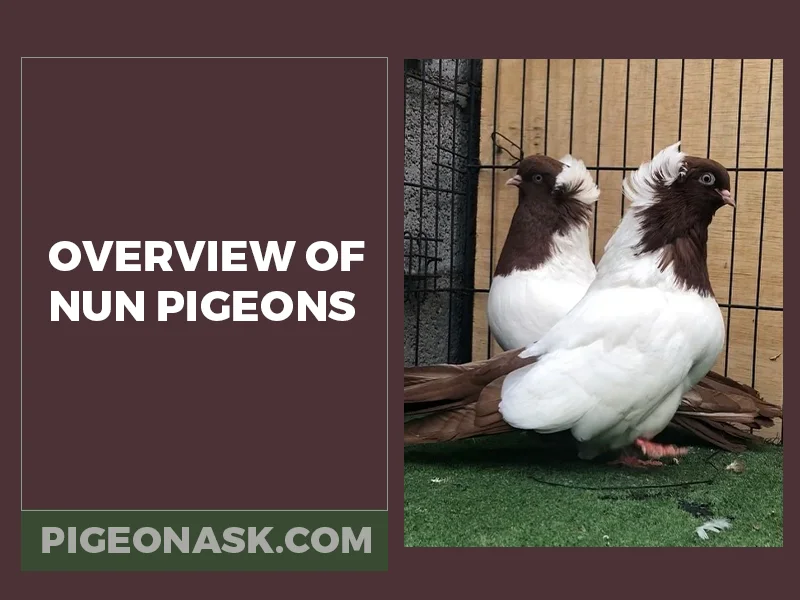
These names roughly translate to the “English Nun” or “Shell pigeon.” The hood of feathers around this pigeon’s head and neck is the main contributing factor to these names.
Being a fancy breed, the nun pigeon is mainly raised for exhibition purposes. There are entire fan bases and clubs devoted to this single breed.
A large number of these fans strongly believe in the pigeon’s spiritual importance. As a result, the demand for this breed is quite unique from most other fancy pigeons.
History And Origins of Nun Pigeons
Like all domesticated breeds, the nun pigeon traces its ancestry back to the Rock Dove. 16th-century naturalist Aldrovandi talks about the nun pigeon in his writings.
You will also find this breed mentioned in the texts of English author Moore’s. Charles Darwin also used the example of the nun pigeon to explain evolution to his readers.
Those texts make the Nun Pigeon one of the oldest recorded fancy breeds in history. However, the forefathers of these pigeons were much different than what you see today.
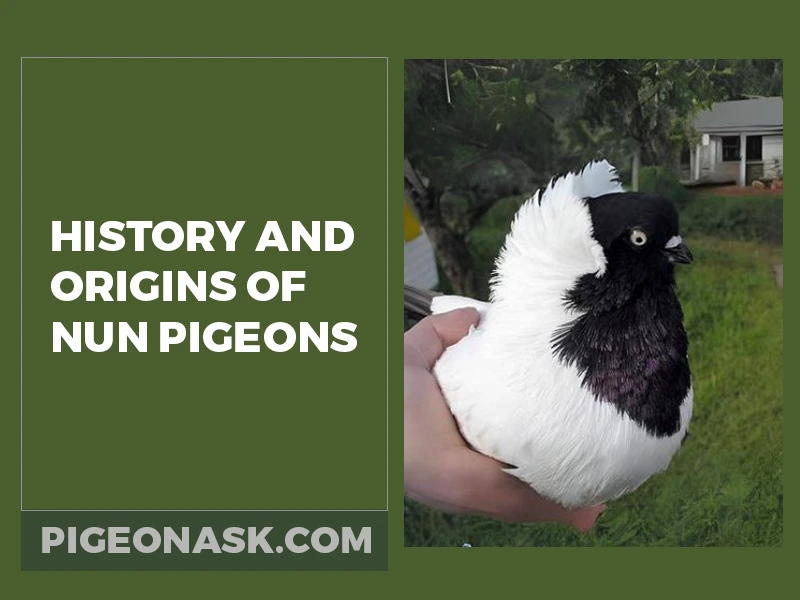
In fact, the original nun pigeons were tumblers. They had excellent flying capabilities and could perform aerial acrobatics.
However, British pigeon fanciers of the 1800s were more interested in the bird’s feathery hood than their tumbling talents. They aimed to create a breed that had a more prominent hood of feathers and more aesthetical eyes, beak and chest.
So, they selectively bred the tumbler nun pigeons with other fancy breeds that had those desired aesthetics.
Gradually, they reduced the tumbling genes and increased the beauty features. Thus, the nun pigeons turned into an exhibition breed from flying tumblers.
Physical Characteristics and Features
The widespread demand for the Nun Pigeon is due to its beauty and unique features. Suppose you are a breeder or a participant in a pigeon exhibition. In that case, these are the physical characteristics you should seek or aim for.
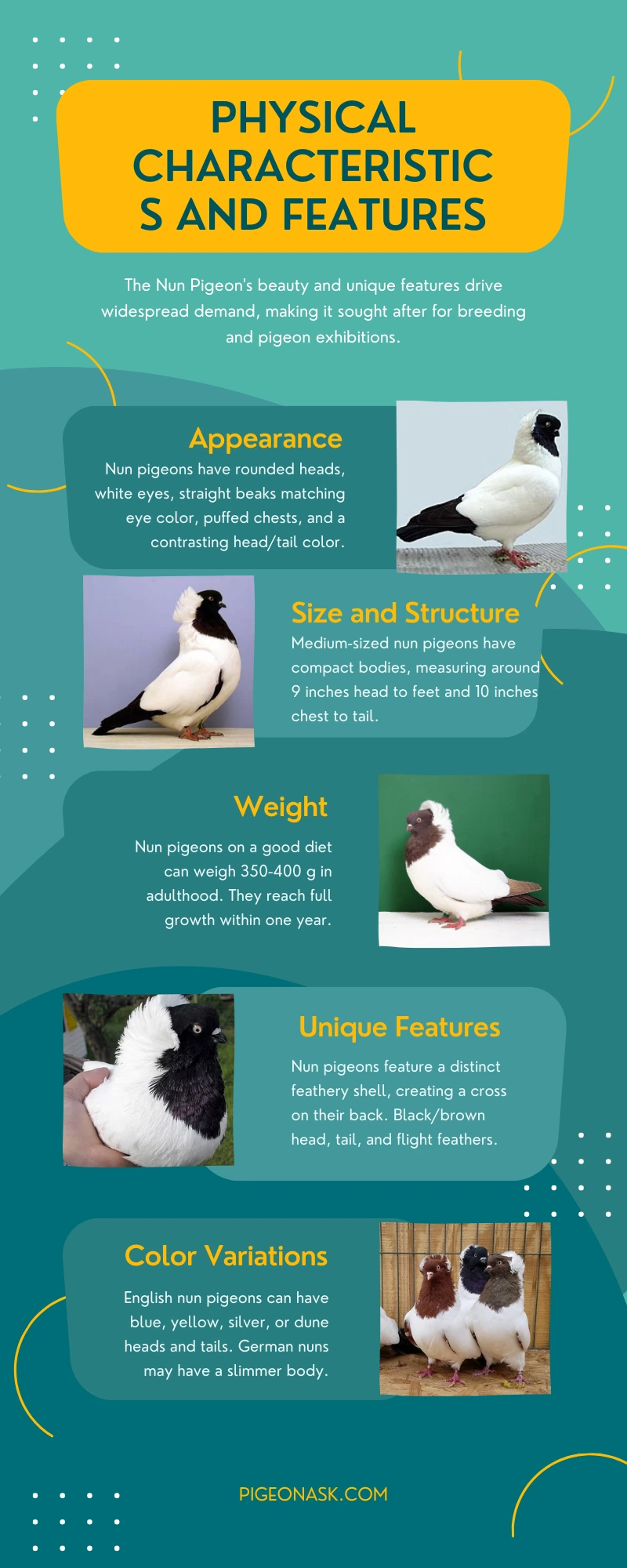
At a glance –
| Characteristic | Description |
|---|---|
| Body Size | 9 to 10 inches (23 to 25 cm) from head to feet for males |
| Feather Colors | Mainly white body with ash-grey, black, coffee-brown, light blue, red, silver, or yellow head, tail, and primary wing feathers |
| Beak Shape | Straight and relatively short, 15-17 mm in length |
| Eye Color | Pearly white or pearl iris with a dark pupil |
| Leg Length | Medium length, usually light red in color |
| Neck Length | Medium compared to the thin head, smoothly descending to the chest and back |
| Crest/Head Ornament | Shell crest covering the back of the head and neck, resembling a Catholic nun’s habit |
| Tail Shape | Flat, long, narrow, consisting of 12 feathers |
| Bill Color | Dark horn for beak, ceres, and toenails |
| Overall Posture | Short, cobby, and stocky appearance with a well-rounded chest and upright carriage |
Appearance
The nun pigeons have a smooth and rounded head. They have pearly white eyes with black pupils and narrow ceres. Their short, straight beaks match the eye color and have small wattles.
These pigeons have puffed-out symmetrical chests, which make them appear strong and confident. The head and tail of the nun pigeon are a different color (black/brown) than the rest of the body (white) with feathered feet.
Size and Structure
The nun pigeons are a medium-sized breed. They have a compact, well-proportioned body structure. An adult male nun pigeon might measure 9 inches from the head to the feet and 10 inches from the chest to the tail.
They have short tails and close-fitted wings.
Weight
A nun pigeon that grew up on a good diet can weigh 350-400 g in its adulthood. They fully grow into their body within one year of hatching.
Unique Features
The feathery shell is the most unique feature of these birds. Their flight feathers at the edge of the wings contrast the rest of the body.
As a result, the folded wings form a cross on the pigeon’s back. Also, the black/brown head, tail and flight feathers make the bird appear like a flying white cross in the air.
Color Variations
English nun pigeons can also have blue, yellow, silver or dune heads and tails contrasting their white body. A common variation is the German nun pigeon.
They are mostly identical to the English Nun. However, they might have a slimmer body, tighter hood, orange eyes and curvy beak.
Distribution And Habitat of Nun Pigeons
The original Tumbler nun pigeons are from somewhere in Europe. However, the variety we see today- English Nun Pigeon, is presumably British.
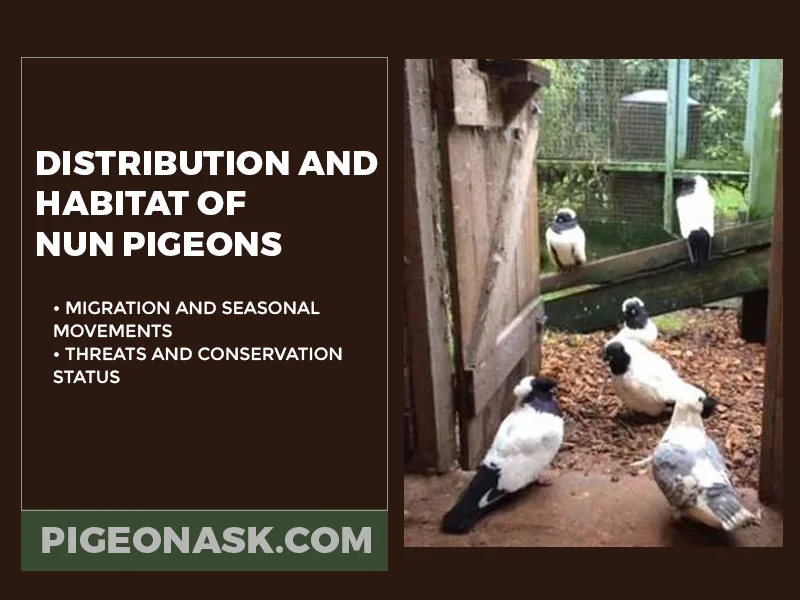
These birds don’t require any special habitat, although they cannot survive extremely harsh conditions.
At a glance –
| Habitat | Suitable for Nun Pigeons |
|---|---|
| Urban Areas | Yes, if housed in clean and spacious cages or lofts within urban environments |
| Rural Regions | Yes, if provided with adequate food and water sources, shelter, and companionship |
| Woodlands | No, as Nun pigeons are a domesticated breed primarily kept within human environments |
| Parks | Yes, as they are used for both flying and exhibition purposes and can be raised as pets |
| Farmlands | Yes, if provided with adequate food and water sources, shelter, and companionship |
| Cities | Yes, if housed in clean and spacious cages or lofts within urban environments |
| Suburbs | Yes, if provided with adequate food and water sources, shelter, and companionship |
| Grasslands | Yes, if provided with adequate food and water sources, shelter, and companionship |
| Gardens | Yes, if housed in clean and spacious cages or lofts within human environments, such as gardens |
| Open Fields | Yes, if provided with adequate food and water sources, shelter, and companionship |
| Buildings and Structures | Yes, if housed in clean and spacious cages or lofts within human-built structures |
| Agricultural Areas | Yes, if provided with adequate food and water sources, shelter, and companionship |
| Human Settlements | Yes, if housed within human settlements in spacious cages or lofts |
The nun pigeon is a popular breed in the UK, USA, Germany, Italy, France, Russia and other European countries.
Being a fancy, domesticated breed, the nun pigeons prefer to live in a clean and spacious loft. They are unlikely to survive extremes, like in a jungle or urban wilderness, like the common feral pigeon.
The nun pigeon isn’t a timid breed prone to illness. However, extreme hot or cold temperatures can hurt them.
Migration and Seasonal Movements
The nun pigeons are a fancy domesticated breed. So, they would spend their lives with their owners or in their lofts. They don’t have any migration routines.
Threats and Conservation Status
The classic English Nun Pigeon is popular. There are even organizations, such as the British Nun Club, that solely promote this particular brand of fancy pigeon.
Their symbolic association with Christianity inspires even the non-pigeon fanciers to adore and conserve the bird.
Behavior And Traits of Nun Pigeons
The Nun Pigeon is a loyal and friendly breed. You can easily tame them and keep multiple pairs together. Due to their non-aggressive nature, they are safe to have around children.
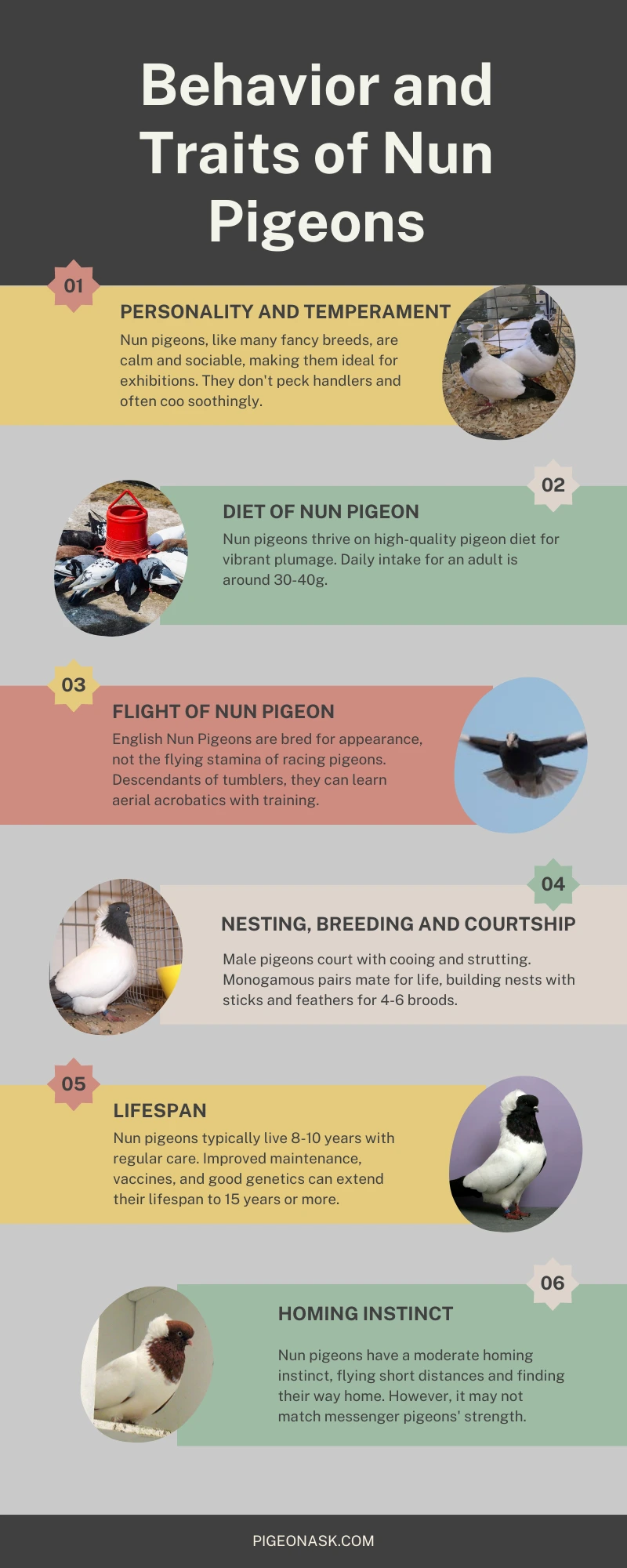
Personality and Temperament
Like most fancy breeds, the nun pigeon is calm and sociable. They don’t flutter peck the handler and are, therefore, perfect for exhibitions. These pigeons mostly keep quiet and sometimes make a soothing cooing sound.
Diet
The nun pigeon feeds on a standard pigeon diet. However, the items need to be of high quality to develop vibrant plumage and other features.
Feed them a healthy mix of seeds, grains, fruits and veggies. An average adult nun pigeon might need around 30-40g of food daily.
Flight
The English Nun Pigeon is exclusively bred for their appearance. So, don’t have the flying stamina of race pigeons.
However, they are descendants of tumblers. Those genes still make them decent flyers. Some nun pigeons can even learn aerial acrobatics if you train them.
Nesting, Breeding and Courtship
The male pigeons try to catch the female’s attention by cooing and strutting. A couple of mates for life build their nest out of sticks and feathers in the nesting box. With proper conditions, you might get 4 to 6 broods a year.
Lifespan
Most nun pigeons live for 8-10 years with regular food and a loft. However, better maintenance, vaccines and good genetics can keep them healthy for longer. For instance, some nun pigeons might live up to 15 years.
Homing Instinct
The nun pigeon has a moderate homing instinct. They can fly to small distances and find their way back home. However, their homing instincts might not be as strong as messenger pigeons.
Breeding And Maintenance of Nun Pigeons
Nun pigeons don’t need a lot of care and maintenance. Then again, minimally cared-for nun pigeons won’t be the center of attention at exhibitions.
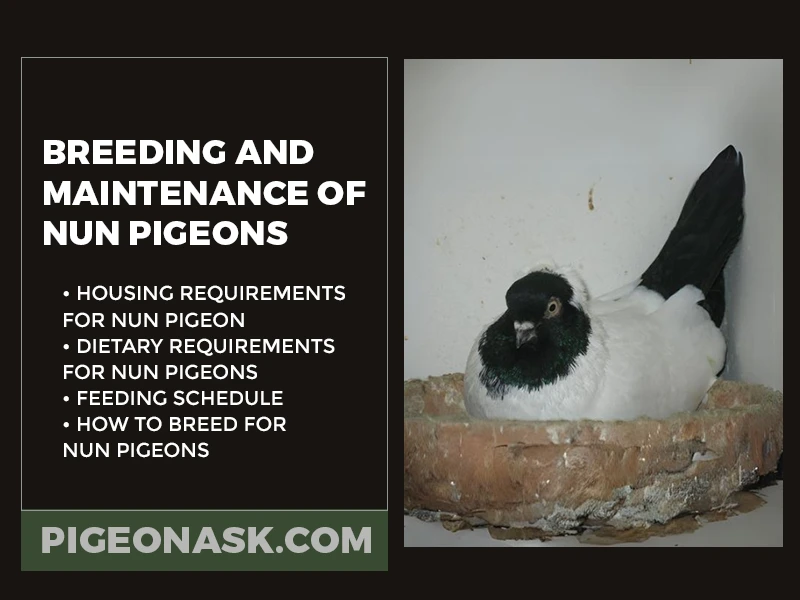
Neither would they live long and yield several broods a year. Therefore, you need to provide them with a quality home, food and care.
Housing Requirements for Nun Pigeon
There’s no point in dictating a fixed dimension for the pigeon loft. You have to work with the space you can manage on your roof, in the garden, or at the farm.
Just make sure the birds get at least 4 square feet of floor space per pigeon and 8 cubic feet of flying space.
The loft should not be short of nest boxes. In fact, experts recommend keeping more nest boxes than pigeons to avoid stress competition.
For instance, those keeping 4 pairs of pigeons should’ve six nest boxes in the loft.
A 12x12x12 cubic inch nest box with a 6×6 square inch entrance is cozy for the average nun pigeon. You should also provide plenty of feeders so the pigeons don’t fight or crowd during feeding.
Ensure proper ventilation, sunlight and warmth in the loft. Lay the floor with straw or sawdust to absorb the dampness from spilled food, water and droppings.
Use nets and bars in the windows to prevent the entry of raccoons, foxes and other predators.
Dietary Requirements for Nun Pigeons
The required amount of food for an adult pigeon is 10% of its total body weight.
You should make it a balanced mix of seeds (50%), grains (25%), vegetables (15%), fruits (5%), pellets (3%), grit (1%) and supplements (1%). Provide plenty of clean water in the loft for the pigeons to drink when they need it.
Sunflower seeds are excellent for Nun pigeons. The fat and protein in these seeds help with the development of healthy feathers. It also provides the necessary energy for daily activities.
Millet seeds are a good source of minerals and can help with the pigeon’s digestion. You should also include calcium-rich Canary seeds, which can contribute to the bird’s bone health.
Corn is an easily digestible grain for pigeons. Wheat contains vitamin B, which helps with the development of the bird’s nervous system. Oats, wheat and barley are some of the other essential grains for pigeons.
Vegetables like spinach, lettuce, cucumber, celery, kale and carrot tops are good for your pigeons. These greens provide them with vitamins A, C and K. Veggies like celery and lettuce have high water content and keep the pigeons hydrated for a long time.
Feed the pigeons two times a day. The morning meal can consist chiefly of grains and seeds. This will provide the pigeons with the energy they need throughout the day. You can keep the greens in the pigeon’s evening meal.
Fruit isn’t a daily requirement. You can occasionally use those as treats. Don’t feed your pigeon scrapes. A pigeon’s digestive system isn’t designed to process the artificial sugar, salt and oil present in human foods.
Feeding Diet Chart
Here’s a diet chart detailing how to feed Nun pigeons –
| Type of Food | Percentage of Total Diet | Role/Purpose |
|---|---|---|
| Seeds | 50% | Source of protein, energy, and healthy feathers (e.g., sunflower seeds) |
| Grains | 25% | Easily digestible, essential for energy (e.g., corn, wheat, oats, barley) |
| Vegetables | 15% | Provide vitamins A, C, K, and hydration (e.g., spinach, lettuce, cucumber) |
| Fruits (Treats) | 5% (occasional) | Occasionally for variation and as treats |
| Pellets | 3% | Supplementary nutrition |
| Grit | 1% | Helps with digestion and provides minerals |
| Supplements | 1% | Additional nutritional support |
| Water | Provided freely | Essential for hydration and overall health |
Feeding Schedule
- Morning Meal: Chiefly grains and seeds for energy throughout the day.
- Evening Meal: Include vegetables (e.g., greens) to provide vitamins and hydration.
Important Notes
- Avoid feeding scraps or human food due to their content (sugar, salt, oil) unsuitable for pigeon digestion.
- Fruit is an occasional treat rather than a daily requirement.
- Ensure access to clean water at all times.
- This diet plan ensures a balanced and nutritious intake suitable for the health and wellbeing of Nun pigeons.
How to Breed for Nun Pigeons?
Choose healthy nun pigeons with the best physical characteristics to produce offspring with desired traits. If the loft is too dirty or chaotic, the pigeons are unlikely to breed.
So, reduce noise and maintain a peaceful environment in the loft. Playing soft music can also help the pigeons to get in the mood.
The nun pigeon lays 1-2 eggs in each brood. Usually, a healthy egg will hatch within 18 days. For the first ten days, the babies will exclusively feed on the crop milk their parents produce. Solid foods start towards the end of the second week.
Usually, the offspring can start flying properly when it’s four weeks old. At six weeks old, the young pigeon is ready to leave the nest and breed. However, experts recommend not to use pigeons younger than one year for breeding purposes.
Conclusion
Whether you believe in the religious association of the nun pigeon or not, raising them can be a fulfilling experience. These birds make excellent pets. Plus, they are in great demand among fanciers. A well-nourished bird can sell for $300 or more.
Pigeons usually need vaccines for paramyxo virus, salmonella, rota virus and pigeon pox. The schedule depends on the bird’s past vaccination status and the formulation available. You should follow the vet’s guidelines here.
So, that’s all for this discussion. If you find it helpful, please share it with the rest of the world. And don’t forget to follow us on Facebook, Twitter and Google News for more content like this.
